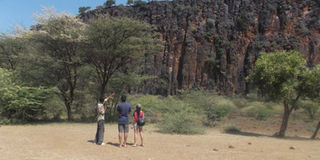An endangered predator

Birding by the cliffs of Baringo. Photo/RUPI MANGAT
What you need to know:
- Rupi Mangat searches for Baringo’s rare, but threatened, Verreaux’s eagle
The Equator crossing at Mogotio promises hot, sunny days in the Northern Hemisphere. Bright yellow flowers of different acacia species and the white bloom of other acacia make it a sensuous drive into the Rift Valley.
The honey vendors at Mogotio are busy with their sales. The beehives hung high in the acacia trees show through the foliage that is competing for space with the invasive weed, the Prosopis juliflora. Towering termite hills break the green-scape, with dry rivers flowing into Lake Baringo.
The famous cliffs of Baringo stand guard over the lake, as they have for eons. Despite it being so hot, we are at the base of the basalt cliffs to see what they are most famous for — the Verreaux’s eagles, also dubbed the African black eagle.
Cliff William Kipror is the Tugen guide who lives by the cliffs and has been monitoring them since he trained as a guide three decades ago.
He warns us that it is too hot to see the eagles at midday but we may be in luck and see them soaring in the sky. Walking in through Kapsoi Bird Watching Field that the community has set aside to safeguard their famous denizens, the basalt cliffs (or chesumei, the Tugen word for cliffs) under the midday sun are a rich earth-red against the bluest of skies. We scan the rock wall — the highest point is 84 metres high — for the Verreaux’s eagles but cannot see them.
Modern dangers
“That’s their nesting site,” says Kipror, pointing to the whitewash on the cliffs — stained by the eagles’ droppings. The good news, according to Kipror, is that they successfully bred this year and the lone chick left the nest in June. The Verreaux’s eagle is a big, strong black bird with a signature white ‘V’ on its back.
The birds can fly in winds of 157 kph, where other birds are flung across the sky. The female is larger and can weigh between three to five kilogrammes and the male slightly smaller. They mate for life.
The cliffs of Baringo are their favourite haunt because these birds of prey are among the most prey-specific of any avian predator, hunting for rock hyrax, a close relative of the elephant.
Hence their territory reflects the hyrax population and as such, these big black eagles are found in areas where the hyrax are. They sometimes take in smaller prey like dikdiks when the hyrax are in short supply. These hunters-on-the-wing swoop around the corners of cliffs to surprise their prey and that is why the cliffs of Baringo are perfect for them.
But like all birds of prey, there is concern for the future as Africa takes to wind energy. Wind farms are normally put in high-lift areas — the same areas that raptors like Verreaux’s eagles like to fly in.
Although environmental impact assessments need to be carried out to minimise this threat, reads a report on Verreaux’s eagles, it is hard to see how wind farms will not have a harmful effect on this eagle if there is an uptake in Africa.
Driving into Robert’s Camp on the shores of Baringo, it is nice to pop into the Thirsty Goat for a drink. It is a legendary camp where Betty Roberts set up home with her husband in the 1950s and opened her garden for campers, crocodiles, hippos, and birds of all sorts.
Reputed to never have locked her doors — even at night — the grand old lady passed away three years ago. Her lake shore house went under water once — in 1963 — and now. As we sail around it, only the rooftop shows.
“We think this could be a 50-year cycle,” says Murray Roberts, Betty’s son who runs the camp. “It’s the highest in living memory. But we don’t know much else because there are no records to go back to. The earliest mention is by Joseph Thomson (the first white man to walk across modern-day Kenya in 1883) who wrote that the eastern side was grassland and acacia woodland.”.




